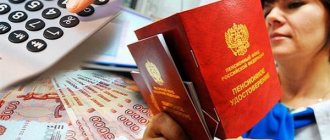The pension system in the republic consists of 3 parts:
- Provision from the state , consisting of a 20% tax from the working population and 13% from the state for medical care.
- Mandatory fund. 2% of a citizen’s personal income and 4% from the state are transferred to it. Such a contribution can be voluntary for Estonians born before 1983. For everyone else, this contribution is compulsory and begins to be debited from the first salary after reaching adulthood.
- Additional pension fund . The citizen determines it independently. It is possible to change the amount of the contribution, the frequency of payments, terminate the contract early or obtain a payment holiday. Such payments are provided to a person starting from 55 years of age. This pension is tax refundable when contributions do not exceed 6,000 euros or 15% of income before deducting expenses. In cases where the contract with the insurer is open-ended, and the funds were there for more than 5 years, then such a pension is not taxed at all.
When concluding an agreement with a specified period or in case of withdrawing the entire amount, the tax is 10%.
The pension currently consists of the basic part, length of service and insurance for those who retired since 1999.
Types of pensions in Estonia
The Republic provides its citizens with the following types of pensions:
- State.
- by age (experience required);
- for disability, regardless of length of service;
- for loss of source of income (intended for disabled Estonian citizens);
- early retirement (when working in a production facility that does not allow working until retirement age);
- support pension (made 5 years after the age) in the absence of another type of accrual.
- Professional. The employer makes the payments. Such contributions can be either optional or forced.
- Voluntary. Contributions are made at the discretion of the future recipient of payments.
Types of benefits
To maintain social stability, the state must provide pensions to the disabled part of the population who have not reached retirement age and are physically unable to pay insurance premiums.
Types of benefits, depending on the circumstances of their assignment, are divided into several categories.
| Pension type | Administrative organization | Type of payment |
| State (1st level) | Social Insurance Department | · old-age pension, including early, deferred and preferential; |
| · loss of a breadwinner; | ||
| · for incapacity (disability); | ||
| · national pension (if a person has lived in the country for at least 5 years, but has no insurance coverage); | ||
| · parental allowance for raising children (for each child born since December 31, 1980) | ||
| Cumulative (2nd stage) | Non-state pension funds (mandatory in Estonia) | 6% of accrued wages are accumulated monthly in the account of the future pensioner, opened in one of the non-state pension funds. |
| Money can only be received after receiving the right to an old-age pension | ||
| Additional storage part (3rd stage) | Insurance companies and banks of the employee's choice | Accumulated premiums and earned premiums can be paid at any time starting at age 55. The payment can be monthly or issued one-time (at the client’s request). |
Retirement age
The retirement age for men in Estonia in 2021 reaches 63 years.
It is important to know! MobiSnab - high-quality winter safety footwear
For the female half of the population, determining this age is more complicated. It depends on the date of birth .
- Those born in 1951 have the right to retire starting from the age of 62, from 1951 to 1953 - from 62.5 years, in 1953 - from 63 years.
In 2021 The Estonian authorities decided that the female half of the population, born from 1954 to 1960, have the right to retire from 63 years or more.
The retirement age limit will gradually increase.
Pension amount
The pension is formed from:
- The basic part is 162 euros.
- Experience share , calculated for work until the end of 1998.
- Insurance share . The amount of this payment is affected by length of service, presence of maternity leave, military service, time of full-time education above average and temporary disability. This payment is calculated for each citizen individually. In addition to these factors, the payment depends on how much tax the citizen has paid since the beginning of 1999.
Important! Each year of service is reflected in a pension of 5.77 euros.
Every year in the spring, the country's government recalculates pensions. The amount of the pension payment is multiplied by an index, 1/5 of which depends on the annual rise in prices, and the rest on the growth in the social tax share. After such recalculation, the pension is paid starting from April 1.
It is important to know! China's pension reform
Average pension
The average pension payment in the republic is 391 euros (24,027 rubles). The amount of the final payment is affected by length of service, pre-retirement income or participation in programs.
If the accumulated experience is 15 years, then a resident of Estonia receives 223 euros, 30 years - 301 euros, 40 years - 354 euros, over 44 years - 375 euros.
In 2021, the Estonian authorities plans to raise pensions by 5.7%.
Minimum pension
If a person has no work experience, then he is entitled to a national pension .
Currently, the minimum pension for an Estonian citizen is 158.37 euros.
Early and delayed retirement
The Estonian state has provided for the possibility of early retirement. There is a certain criterion that allows you to start receiving assistance three years earlier: having 15 years of work experience, but at the moment there is no official employment.
One should take into account the fact that the amount of monthly payment in case of early retirement will be less than usual. The pension amount is reduced by 0.4% for each missed month. That is, in 3 years the Estonian will lose 14.4% of the due amount.
Persons engaged in a certain type of activity also have the right to receive an early pension:
- work in the police, prison and security organization;
- mining industry;
- naval service;
- teaching activities;
- social workers;
- HIV-infected medical workers.
How long a person must work and the retirement age for each of the above categories is established by the Law “On Long Service Pensions”. According to the same law, some categories receive an additional bonus.
Deferred pension
You can apply for a pension for work experience in Estonia later than the due date. An additional few years of work is highly encouraged by the Estonian government. As compensation, the person is offered an increase in the monthly benefit. In this case, for each one month deferred, an increase of 0.9% is due. So, for 2 years of deferment, the pensioner will receive 21.6% more than his compatriots who retired at 63 years old.
Pension schemes
Payments in Estonia are calculated according to several schemes:
- Pension upon retirement
The payment is made from available funds in the account or from the capital of “today’s” taxpayers. The scheme is not very relevant, since the population is decreasing and creating a negative increase.
- Pension with specified contribution
It implies the assignment of an exact amount of regular contribution to the pension fund (percentage of income), which is not guaranteed and depends on the duration of the scheme.
- Scheme with assigned payment amount
Based on a specified retirement benefit amount. Contributions depend directly on the desired result, length of service and salary during the pre-retirement period.
- Payments
Depends on the amount of savings at the time of reaching retirement age.
Reform on the march: Estonian pension funds lost almost 1.3 billion euros
At the beginning of 1999, the procedure for calculating pensions changed. Starting from this time, a person does not need to confirm his work with a work book or other documents. The amount of retirement experience and pension for this period is calculated on the basis of the social tax paid for the person. The state has this data automatically and the Social Insurance Board receives it directly from the Tax and Customs Board.
The size of the insurance portion depends on the amount of insurance shares. To find it, the social tax paid per person during the year is divided by the average social tax of the state for that year. If the social tax paid for a person is greater than the average in the state, the person receives an insurance share greater than one. If the social tax paid for him is less than the average in the state, he receives an insurance share of less than one. To obtain the insurance part, the amount of insurance shares is multiplied by the annual coefficient, as in the case of the part based on length of service.
From the beginning of 2021, everyone's pension will be accumulated based on a new logic. “If the current system were to continue, the disparity between people with different incomes would widen; people who receive lower salaries today would receive even lower pensions in the future. By reforming the pension system, we strive to ensure that the pension system in a society with an aging population provides a decent income for everyone,” explained the head of pension policy at the Ministry of Social Affairs, Kristiina Selgis.
We all have our own habits. For some it’s a visit to the theater or training, for others it’s a car trip out of town, for others it’s coffee with a friend in a new cafe or on a park bench.
Apparently, such habits inevitably require money - and often we ourselves are not aware of how much money we spend on small habits. Still, it's worth thinking about. This will help you make a choice before reaching retirement age so that you don’t have to endure any special hardships at the retirement stage of life.
Here a person independently decides on the amount of deductions. For normal existence, future payments should be 65% of income. The first two levels will give 40%, and the remaining % will be collected by the future pensioner himself.
The total amount of the benefit is calculated as the base amount (160 euros), bonuses for the length of service worked before 01/01/1999 and the amount of the insurance share. Each pension applicant has its own specific calculations.
Important! Payments are required to increase by 5.7 euros for each year worked.
Life in the Baltic state is slightly more expensive than in Russia and Ukraine. The average bill in a cafe for two here is 8-10 euros, in a restaurant – 15-25 euros. A one-way trip on public transport costs 1.5 euros, the same price as a liter of gasoline. Prices for products in Tallinn supermarkets:
| Name | EUR |
| Water (0.5 l) | 0,7 |
| Beer (0.5 l) | 1,5 |
| Imported alcohol (0.75 l) | 5-6 |
| Carbonated drinks (0.5 l) | 0,9-1 |
| Cereals (1 kg) | 1,4 |
| Milk (1 l) | 0,8 |
| Tomatoes | 2,2 |
| Bakery products | 0,3-0,6 |
| Bananas | 1,16 |
| Oranges | 1,3 |
| Apples | 1,3 |
| Potato | 0,38 |
| Meat | 5-6 |
| Cheeses | 6-7 |
| A dozen eggs | 1,3 |
| Chocolate bar | 0,5 |
| Chocolate bar | 1 |
Local residents recommend tourists buy groceries in stores and cook their own food, since daily visits to coffee shops and restaurants are very expensive even with a well-planned budget.
Pensions in Estonia for Russians
This year, the pension for Russians living in Estonia is 312 euros .
Many citizens seek to go to other European countries to earn money. The outflow of young people is so large that pensioners make up almost half of the population of Estonia.
Because of this state of affairs, the retirement age for Russian citizens can be raised to 74 years, and the length of service to receive a pension can reach 44 years. Only in this case the payment amount can increase to 396 euros.
When calculating the pension, the day of the month when the application for receiving it is submitted is taken into account. The initial payment includes the amount of unpaid funds from the date of application. Thus, a person receives a payment in the amount of a pension for several months.
It is important to know! Tire Pressure Sensors TPMS
Situation for Russian citizens
For Russian citizens, the pension in Estonia is 312 euros (that’s almost 23 thousand rubles). The government often notes that the country has a difficult time providing for pensioners.
Changes in retirement age in different countries
This is due to the fact that many citizens, and primarily able-bodied young people, seek to go to more economically developed European countries in order to receive higher salaries there.
The outflow of young people in recent years is so great that now almost half of all citizens in the country are pensioners. In this regard, it is expected that conditions for Russian pensioners may change in the coming years.
In particular, the likelihood of raising the retirement age for Russian citizens to 74 is being discussed. At the same time, the minimum length of service for applying for a pension will reach 44 years. True, the pension itself will be much higher – 396 euros (that’s almost 29 thousand rubles).
Transfer of pension from Estonia to Russia
Estonia and Russia have concluded an agreement on mutual support for pensioners. In both countries, the amount of this payment directly depends on the length of service obtained in the territory of each state separately.
If in retirement a person moves from Russia to Estonia or vice versa, then the cash payment to him is made by the country that accumulated the funds.
Estonian citizens who find themselves in Russia are deprived of the national part of the pension, but receive the right to benefits from Russia.
The disadvantages of such a move include:
- lack of a pension for the loss of a working family member;
- When funds are credited to a bank account, euros are converted to rubles. Due to the difference in the exchange rate and the bank's interest rate, a certain amount of money is lost for servicing.
The pension is paid in a specialized institution on the 20th day of every second month of the quarter. The currency exchange rate corresponds to the Central Bank.
Absolutely all pensions paid to citizens abroad are subject to income tax; there are no exceptions.
Average standard of living of older Estonians
As it might seem at first glance, all Estonian pensioners are well off. But after paying utilities and buying medicine, you are left with 2 euros a day to survive. Whether this is a lot or a little can be found out by comparing it with the prices of grocery products.
Elena Smirnova
Pension lawyer, ready to answer your questions.
Ask me a question
Food prices in Estonia are very high. For example, 1 kg of bread costs 1 euro.
To improve the lives of older people, a number of benefits have been introduced in the country. They are exempt from paying for transport. In terms of life expectancy, they lead compared to Russia by 2.5 years. But Estonians have to work longer.
The main indicator of the welfare of each country is the number of emigrants. About 30 people from Russia emigrate to Estonia every year.
All opportunities are open for pensioners to travel to Schengen countries. But they have very few opportunities due to the retirement age threshold and life expectancy.
Prospects
In the future, the Estonian authorities plan to radically change the pension system of the republic. Payments will be such that pensioners no longer need anything. Pension income must be sufficient for normal living in the country.
Residents of the republic will be given the opportunity to independently choose the time of retirement, make partial payments, freeze them and resume them.
The retirement age will correspond to life expectancy, and may reach 70 years. The proposed changes will not affect current citizens of retirement age and accumulated shares.
Watch the video: Estonia is going to pay pensions to citizens living abroad.
Pensions in Estonia are formed from a number of important points, which become stricter every year, but affect the amount of payments. And if, after working in the republic for some time, a person decides to move to Russia, it is recommended to have impressive work experience in the territory of the pension fund.










